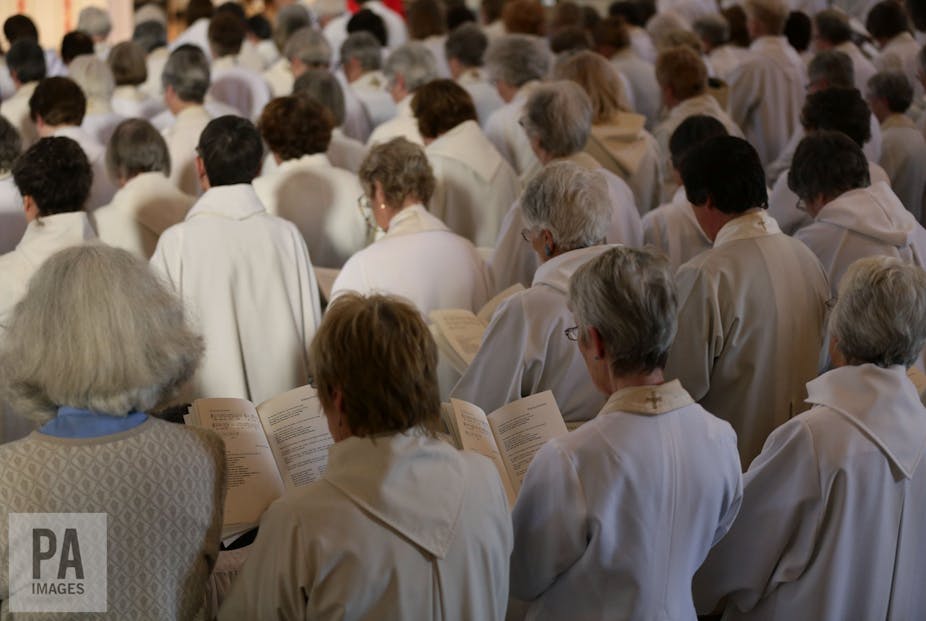The Church of England is the latest institution to be swept up in the #MeToo wave of disclosures about sexual abuse and harassment. As Rachel Trewick, the bishop of Gloucester told the Guardian, it’s dangerous to imagine that the “church is somehow an elite group of people” immune from the issue of harassment. In an interview with Channel 4 News, Jayne Ozanne, a senior lay member of the church, said she thought sexual harassment and abuse was widespread within the church.
My ongoing research into how women clergy negotiate their belonging in the Church of England suggests that the institution has a uniquely problematic relationship with sex and gender. The stories I’m hearing from women priests about everyday unhealthy and humiliating practices based on perceptions of gender are in many ways no different to the stories lots of other women might tell.
Yet, women clergy must also negotiate a system whose symbolism is dominated by men in their bid to belong within the institution – and access power. Life has not been easy for women in the church: a male saviour, sent by God with masculine names, a traditionally male priesthood, a male-oriented history, a creation myth that casts the woman as temptress, and the battles required to read Biblical text in a non-sexist way. The legacy of Christian culture is that men and women are constructed as different, in ways that hand power to men.
Women clergy are awake to the ways in which this plays out. As priests, they must slay the demons attached to the myth of being different-but-equal. Roles and attitudes expected of women that are hidden in “feminine” traits undermine their leadership and authority in subtle ways. For example, the way they look is constantly judged and evaluated. One woman recounted that she was told the feminine timbre of her voice made her inaudible.
Sanctioned sexism
More significantly for these women, their priesthood remains contested by some in the church. This is a stumbling block with which the Church of England must deal before women are seen as spiritually, symbolically and humanly equal to men.
After 1994, when women were first ordained, a structure was set up to accommodate those who believe the priesthood is exclusively male. Known as the “two integrities” it is designed to allow “mutual flourishing” of those who accept women can be priests and those who do not, validating both positions. The church has thrown a protective boundary around those who believe that God strictly differentiates between male and female, particularly in rituals, in leadership and in representation of the divine. Women clergy are left to find ways of negotiating this boundary, rather than resisting it.
The two integrities arrangement prevents ordained women from applying for certain parish priest positions or performing rituals for certain groups, such as Holy Communion. They must work alongside, and often minister to people who do not recognise their status as priests because they are women. In any other institution in the UK, this would be illegal. This situation is deeply damaging to women’s status in the church. It officially sanctions those who see women as alien to the priesthood – and this has an impact on the way some men in the institution view and interact with women.
Little space to protest
The ability for women to protest and resist sexism in the Church of England remains limited. Women clergy often feel they can exercise the power of protest only in ways that go unnoticed. According to my conversations with women priests, changing sexist language in hymns when no one can hear, for instance, is a way of resisting without attracting rebuke from congregations and church hierarchy.
When women in the church protest more overtly, the backlash is significant. The nomination of Philip North as bishop of Sheffield, drew protests from women clergy and their allies because of his well-known stance against women’s ordination. They resisted working with a man in authority who did not openly acknowledge female priesthood. North withdrew his nomination in March 2017 after the public protest, but the ensuing discussion cast him as vulnerable and wounded and the female protesters as bullies. Church leaders reacted with a call to “disagree Christianly”, but in my view this effectively silences those in the church who see injustice against women continuing around them.
The Church of England should now look to improve its systems for reporting and dealing with sexually abusive behaviour. But if women clergy are stymied in their ability to protest loudly and at will about what they perceive as sexist structures and theologies, a systemic change in the way women are treated in the Church of England is unlikely to happen. Given that women clergy are seen as different to male clergy by some in the church, this will only ever deal with the symptoms of sexism, not its root causes.

